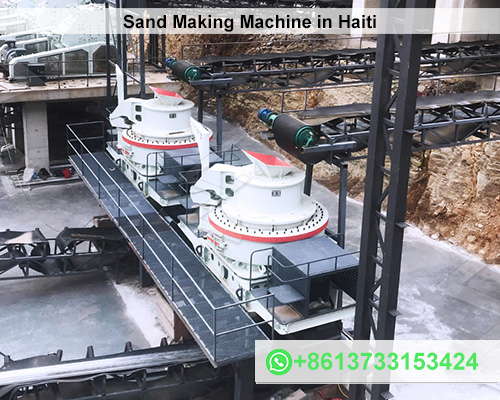Sand Making Machine in Haiti
The construction industry in Haiti faces a unique set of challenges that hinder its growth and sustainability. One of these challenges is the reliable and cost-effective supply of sand, a key ingredient in concrete, mortar, and other construction materials. In recent years, sand making machines have emerged as an innovative solution to address this issue, offering a sustainable way to produce quality sand from available raw materials. In this article, we’ll explore the importance, types, and potential impact of sand making machines in Haiti’s construction sector.

Why Sand is Essential for Haiti’s Construction Industry
Sand is crucial for building infrastructure such as roads, bridges, and buildings. In Haiti, where rapid urbanization and reconstruction are underway, the demand for sand is especially high. Unfortunately, the traditional extraction of sand from rivers and beaches has led to severe environmental degradation, soil erosion, and a disruption of local ecosystems.
By implementing sand making machines, Haiti can meet its construction material needs while reducing its dependence on environmentally harmful sand mining practices. This shift could support Haiti’s infrastructure development sustainably and cost-effectively.
How Sand Making Machines Work
Sand making machines are designed to crush and grind rocks into fine, usable sand that meets construction standards. These machines are typically compact, efficient, and environmentally friendly, allowing them to produce high-quality artificial sand with consistent grain sizes.
The primary mechanism of a sand making machine often includes:
- Crushing Chamber: Raw materials such as stones, rocks, or even construction debris are fed into the crushing chamber, where high-speed rotors crush the material into sand-like particles.
- Grinding Mechanism: Once crushed, the material is further processed to achieve finer particles. This is usually done by grinding or further impact.
- Screening System: The sand produced is passed through a screening system to ensure that particles meet specific size requirements.
By allowing construction materials like limestone, basalt, or even granite to be used as sand substitutes, these machines offer a versatile and sustainable option for Haiti’s construction industry.
Types of Sand Making Machines Suitable for Haiti
Several types of sand making machines could be suitable for Haiti, each with specific benefits depending on the raw materials available and the scale of production. Here are a few commonly used types:
- Vertical Shaft Impact (VSI) Crusher: VSI crusher is popular for their ability to produce high-quality, well-shaped sand particles. Their small footprint and energy efficiency make them ideal for local sand production on smaller scales, which is suitable for Haiti’s community-based projects.
- Hammer Mills: Hammer mills crush materials into sand by impacting them with rotating hammers. They are well-suited for smaller, localized sand-making operations and are cost-effective for smaller construction companies.
- Roll Crusher: Roll crusher use two rollers to compress materials into smaller sizes. These machines are efficient at producing sand from softer rocks and are relatively inexpensive, making them a good choice for Haitian entrepreneurs.
Each type of machine offers unique benefits and can be tailored to the specific needs of Haitian construction projects.
Economic and Environmental Benefits of Sand Making Machines in Haiti
Sand making machines could have a transformative impact on Haiti’s construction industry. Here’s how:
- Reduced Import Dependency: Haiti currently imports a large amount of construction sand, which can be costly and subject to market fluctuations. By producing sand locally, Haiti can reduce import costs, benefiting the local economy.
- Job Creation: Setting up sand-making operations in Haiti could create jobs in mining, machine operation, and maintenance. Skilled operators and technicians are essential for maintaining these machines, promoting local workforce development.
- Environmental Protection: Traditional sand mining has devastating effects on the environment, such as water pollution and coastal erosion. Sand making machines, which use available rocks or construction waste, reduce the need for unsustainable sand mining practices, preserving Haiti’s natural resources.
- Support for Sustainable Development: Haiti’s construction sector is growing, but to do so sustainably, it must adopt more environmentally friendly practices. Sand making machines align with the United Nations Sustainable Development Goals by promoting responsible resource use and protecting ecosystems.
Challenges and Considerations
While the benefits are significant, there are also challenges to consider. Sand making machines require capital investment, maintenance, and skilled labor for efficient operation. Moreover, the production and transportation of sand must be carefully planned to ensure local demand is met without excessive environmental impact.
To maximize the potential of sand making machines in Haiti, government policies and industry partnerships can play an essential role. Support from local and international organizations could help provide financing, technical training, and infrastructure, empowering Haitian communities to operate these machines successfully.
Conclusion
Sand making machines represent an innovative and sustainable solution for Haiti’s sand needs, providing a valuable resource for construction while reducing environmental damage and import dependency. With the right support and implementation, these machines could support Haiti’s economic growth and improve the quality of life for its citizens by contributing to better infrastructure. By investing in locally produced sand, Haiti can move toward a more sustainable, resilient, and self-reliant construction industry that meets the needs of its people and future generations.









